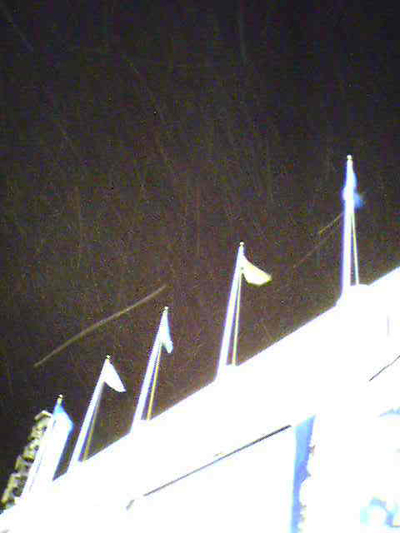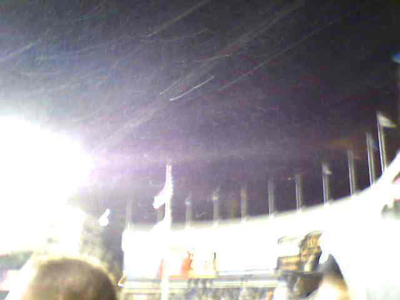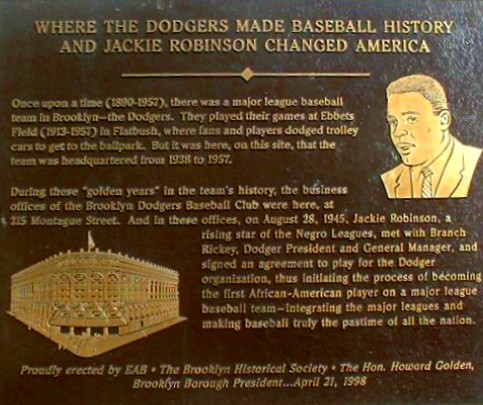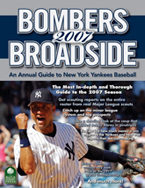I’ve been thinking about Jackie Robinson lately, and not just because today is the 60th anniversary of his major league debut, the momentous occasion that broke the big leagues’ color barrier and changed the face of this country. Recently I stumbled across a monument to another key step in Robinson’s journey, and over the winter he popped up in two seasonal narratives I wrote for the forthcoming It Ain’t Over Till It’s Over: the Baseball Prospectus Pennant Race Book.
Robinson wasn’t an active player in either of those chapters, one on the 1959 NL race and the other on the 1967 AL race, but telling either story was impossible without him. One can’t talk about the Dodgers’ success just prior to 1959 without noting the jump they got on the rest of the NL by leading the way in integration. Still based in Brooklyn, the Dodgers won six NL pennants during Robinson’s ten-year career (1947-1956). Such was the surplus of black players they signed that they seeded other teams with talent. For example, Sam Jethroe (1950 NL Rookie of the Year) and Jim Pendleton were both traded to the Braves, and Roberto Clemente was lost to the Pirates in the Rule 5 draft. Key members of the 1959 Los Angeles team like Johnny Roseboro, Charlie Neal, and Maury Wills spent five to eight years in the minors waiting their turns, not even cracking the starting lineup until the team moved across the country.
As for 1967, one can’t explain the Red Sox’s nearly two decades of futility leading up to that point without digging into the franchise’s shameful history of racism. The Sox were the last team to integrate, not doing so until July 21, 1959 via infielder Pumpsie Green, but ironically, the club actually had first crack at Robinson. On April 16, 1945 — a day short of two years prior to his major-league debut — the Sox granted Robinson, Jethroe, and Marvin Williams a tryout at Fenway Park. That tryout was the result of some political hardball by Boston city councilman Isadore Muchnick, who threatened to block the team’s “Blue Law” waiver (required so they could play ball on Sundays in Boston) unless they were willing to consider black players. As the coaches worked the three players through their tryout, the Red Sox brass — owner Tom Yawkey, GM Eddie Collins and manager Joe Cronin, all with long histories of racist actions under their belts — looked on in disinterest. One account even had one of those three yelling, “Get those niggers off the field!”
Ultimately the Red Sox judged the players not to be of major-league caliber. Yet six months after the tryout, Branch Rickey drove a golden spike into the Gentlemen’s Agreement which prevented clubs from signing black players by signing Robinson to play for the Dodgers’ Montreal club the following year.
I knew little about the Boston tryout until I began researching the chapter, but its details, as well as the various dark incidents that followed in its wake over the next decade and a half — a sight-unseen dismissal of Willie Mays, at whom they also had first crack, manager Pinky Higgins’ declaration that “There will never be any niggers on this team as long as I have anything to say about it,” and the general tolerance for intolerance that prevailed among the coterie of drunk racists who ran the Sox — are recounted to great effect by Glenn Stout in Red Sox Century and Howard Bryant in Shut Out: a Story of Race and Baseball in Boston. The happy side of the story for the Sox is that by 1967, the influence of GM Dick O’Connell — the first non-crony to handle the team during Yawkey’s thirty-plus years of ownership — had resulted in the development of George Scott, Joe Foy, and Reggie Smith, three homegrown black regulars in the lineup, as well as the acquisition of top reliever John Wyatt and, later in the year, reserve catcher Elston Howard. All played parts in the team’s 1967 pennant. Only by catching up to the times were the Sox able to succeed.
Back to Robinson, to mark the anniversary, more than 200 players, including six entire teams, will wear his number 42, which was retired leaguewide a decade ago (Mariano Rivera is the only still-active player among those who were allowed to wear 42 under a grandfather clause). The gesture, which began when Ken Griffey Jr. personally requested a dispensation to wear the number, has evoked criticism from a number of different angles. Among players, Torii Hunter spoke out that the number of those wearing 42 diluted the significance, while some writers have pointed out that the the Astros, one of the teams slated to blanked the field with the number, don’t have a single African-American player.
All of which points to the awkward timing of the anniversary. According to recent reports, just nine percent of players on major league Opening Day rosters were African-American. That’s down from 17 percent a decade ago and from a peak of 27 percent in 1975. Worse, it’s less than the 2005 U.S. Census estimate that 12.25 percent of this country’s population is African-American. At the management level, things are even more dire. Willie Randolph and Ron Washington are the only African-American managers, and Kenny Williams the only African-American GM. Laments that baseball is losing the inner-city African American athletes to the NFL (66 percent black) and NBA (77 percent black) abound. That’s the result of 60 years of progress? Hardly good news.
At the same time, overall minority representation on baseball’s playing fields offers a more encouraging picture. According to 2006 figures from Richard Lapchick of the the Institute for Diversity and Ethics in Sports, 29.4 percent of major leaguers were Hispanic, while 2.4 percent of them were Asian. Combined minority representation in rosters was 40.5 percent last year, down from the all-time high of 42 percent established in 1997. But outside the lines, the numbers continue to languish even if the management count is expanded to include minority managers (Manny Acta, Fredi Gonzalez, and Ozzie Guillen) and GMs (Omar Minaya).
I don’t have the prescription to right the wrongs of minority representation within the game any more than the likes of Peter Gammons, Buster Olney, or any other pundit do. But here’s a suggestion: instead of these awkward decennial tributes on April 15, make Jackie Robinson Day into an annual event that benefits the Reviving Baseball in Inner Cities (RBI) initiative. MLB funds RBI at a paltry level of about $1 million a year, which isn’t going to go very far. By my back-envelope calculations, if every team donated its April 15 gate receipts, at an average ticket price of $22.21 and an average attendance of 31,307 (both numbers based on last year’s figures), that’s $10.4 million leaguewide, a huge leg up for a worthwhile program that can help baseball reassert its capacity to lead rather than follow, and to gain some of the ground it’s losing to other sports.
But bemoaning the current shape of things shouldn’t dominate this anniversary. Instead we should remember Robinson’s excellence as a player, his incredible courage and grace under pressure in overcoming the obstacles that were put in his path, and the way baseball led the nation on the issue of integration. Robinson’s debut preceded landmark moments such as the Supreme Court’s Brown v. Board of Education ruling by seven years, Rosa Parks’ bus ride by eight years, and the Civil Rights Act of 1964 outlawing discrimination based on race color, religion, sex or national origin by 17 years. Jackie Robinson was ahead of his time.
What Robinson did starting 60 years ago today was nothing short of heroic on a level that transcended baseball, and all of sport. It may sound like a hoary cliché, but he showed how one person can make a difference, and that’s a story that should never get old.




